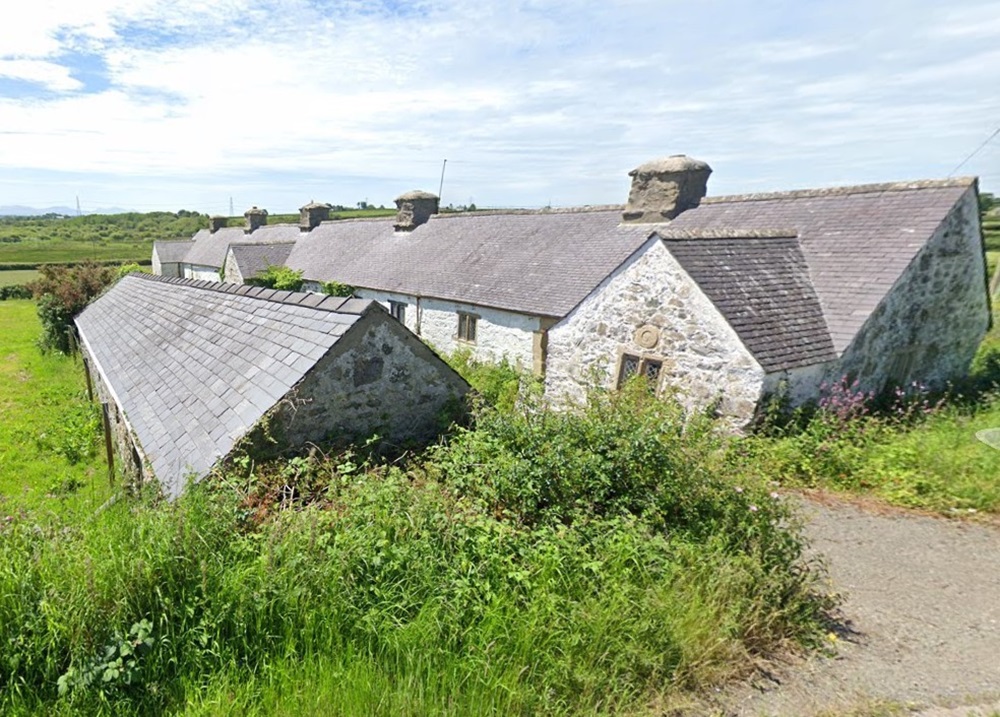Four hundred year old almshouses could become starter homes for young people

Dale Spridgeon, local democracy reporter
An empty row of 17th century almshouses could soon be at the heart of an estimated half-million pound development to create starter homes for young people.
Plans for an “exciting” renovation scheme on Anglesey has been revealed by the trustees of the Grade II listed Penmynydd Almshouses – also known as the Lewis Rogers Almshouses
The tiny homes built around 1620, were originally designed to house the destitute of ‘good and honest” character and were occupied for the best part of 400 years, and managed by trustees.
The idea for the almshouses originally come about because of the will of a barber surgeon Lewis Rogers who died in London, in 1618.
Due to a lack of funds in his estate the scheme was taken on and expanded by his friend Lewis Owen – who had been a ‘Serjeant of the King’s Larder’ to James I’- and is believed to have connections to the Tudor dynasty of Penmynydd.
Shelter and relief
The homes were originally built to provide shelter and relief for those from the Pentraeth, Llanddyfynan, Llanfihangel, Ysgeifiog areas.
The last residents moved out several decades ago and since then they have remained unoccupied and started to fall into ruin.

Now, in a scheme to breathe new life into the properties, the trustees are hoping to develop them into homes which could be rented out at “a social housing level rate, possibly lower, ” to help local young people in the area find affordable homes.
“It’s really exciting project, and the beauty of it is it is being run by local people for local people,” said chair of the trustees Dafydd Idriswyn.
“We’ve identified a need for two bedroomed homes for young people in the area. Affordable homes in rural parts of Anglesey are just about impossible to come by.
“Often social housing schemes are aimed at more urban areas, but in rural areas there are fewer homes, and what houses are there are often snapped up for holiday accommodation.
“The almshouses were always intended to help people but we hope they will now be used to give younger members of the local community a start in life.
“We estimate it could cost about £600,000, we have had help to put together a business plan, we have reserves, and we are seeking match funding and applying for grants, but we would love to hear from anyone interested in helping to support this project.”
Over 50s
The almshouses were originally aimed at housing 10 men, over 50, (wives allowed) – two women could make up the 10 – although that rule was discontinued in 1819.
However, Dafydd notes that the trustees are in the process of updating the former outdated rules.
The sturdily built stone row with tiled roofs are surrounded by fields. They were originally made up of 10 single room dwellings.

Small and basic, they had ‘crog-loft’ bedrooms accessed by a ladder, and residents got a patch of garden to grow food and were given an allowance.
The layout of the homes were later changed – they now form five separate residential units – but the trustees are hoping to create three larger, extended homes.
“The almshouses still retain many of their original 17 century features, we have to keep them, but it all adds to the cost of the project,” said Dafydd.
A row of sheds, added in the 19th century for storage and for washrooms, will also be updated and a new sewage system put in.
Notable features include the large stone chimneys, stone mullions, door lintels, and lead glazed windows to be retained with modern double glazing additions.
Other features include a carved date stone of 1620 and over several doors the initials LR.
According to Dafydd, the very last resident was believed to be Tom Brown, who lived at No 2. His door is marked with the word ‘Brown.’
Memories
Dafydd said: “We asked locals for any memories of the people who had lived at the almshouses, and some interesting stories emerged.
“One is about Tom Brown. He got told off for painting his door brown – the rules said the doors must be blue -but in a small protest he painted it blue – but with his name in brown ‘Brown’ across the door.”
Academic Sylvia Pinches, who contributed a chapter on ‘Anglesey almshouses’ in the book: The British Almshouse: new perspectives on philanthropy ca 1400-1914, has helped the trustees in their research,.
She wrote: “Less is known of the background of Lewis Rogers of Penmynydd, until he was made free of the Company of Barber Surgeons in London on June 30, 1590.
“He had been apprenticed to Robert Balthrop, who was Serjeant Surgeon to King Edward VI and Queen Elizabeth, until his death in 1591 when he mentions Lewis Rogers in his will. Rogers was elected Warden of the Company in 1614, 1616 and 1617 and looked likely to have been Master had he not died.”
He died in East Greenwich, in 1618.
She notes Rogers had promised £1000 to be employed by the direction of Owen Tudor Esquire of Penmynyth [Penmynydd] county Anglesey and Mr Hugh Williams of Esceivioge [Ysceifiog] for erecting and building of an almshouse in the parish for ten poor men, “being of honest conversation, all above the age of fifty”
When it became apparent that Rogers’s estate could not fund the almshouses Lewis Owen stepped in. Sylvia wrote that Lewis Owen “was probably the grandson of OwenTudur Fychan of Penmynydd. Lewis Owen had taken the court route, and became Serjeant of the Larder to James I.”
She also described how he had promised Rogers on his deathbed that he would carry out his wishes, and would oversee the almshouse project.
He provided two acres of farmland at Penmynydd, and gave the profits of the rectory of Eglwys Rhos, Caernarfonshire, out of which £63 per annum was paid for the almshouses.
Lewis Owen died in 1624, and his will made provision from the rectory profits, to include payment of a preacher to provide 12 sermons at £7 a year and for relief of the almshouse poor. From their inception, the almshouses imposed strict rules imposed on its inhabitants.
One stipulation included the compulsory attendance at Penmynydd’s church – St Gredifael. Among the rules residents had to be over 50, could not have children under 12, were not allowed to marry anyone under 50, could not to be absent for more than three days and nights with fines were imposed for periods away.
‘Misdemeanours’
They were forbidden to beg , take in lodgers or have overnight visitors, swearing, drunkenness, and brawling or any other “notorious misdemeanours” were seriously frowned on with the threat of fines, removal of allowances or even expulsion.
There were many ups and downs in the fortunes of the almshouses, and the records are full of colourful descriptions of disagreements.
At times, the trustees report difficulty finding residents ‘of suitable character’ to fill vacancies, whilst residents complained of the poor state of repairs and stoppages in their money.
Following the rise in Non-Conformism a row also ensued over the stipulation to attend the parish church. By the 19th century, some of the alms people had started to attend a local chapel – not the parish church – against the rules – which resulted in 1893 in the expulsion of William Jones.
His cause was taken up by Ellis Jones Griffith the Liberal MP for the county and the rising radical MP Lloyd George apparently brought the matter up in the Houses of Parliament, which resulted in an inquiry, and changed church attendance rules.
Support our Nation today
For the price of a cup of coffee a month you can help us create an independent, not-for-profit, national news service for the people of Wales, by the people of Wales.







Am syniad hyfryd. Great idea. With a change in the outdated rules of course
Arbennig